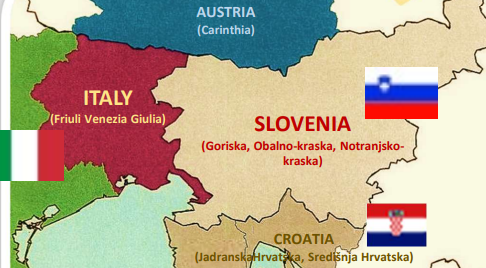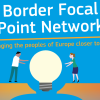Labour market integration is one of the most impactful efforts that can be undertaken in cross border cooperation for the daily lives of citizens. Differences in legislative, labour, social security, pension and other systems between the countries involved, usually dismay workers and employers to look for solutions across the border. As a response, many cross-border areas, have identified the potential benefits for further labor market integration leading to the set-up of specialized institutions whose aim is to assist in pairing employers with workers from across the border. In this article we explore one of those initiatives, namely the Euradria project in the Slovenian and Italian borders.
What
EURADRIA emerges as an exceptional labour market cooperation project in the cross-border region connecting Italy and Slovenia. The primary aim of the project is to foster the free movement of workers and address barriers to cross-border labor mobility in the area, offering a diverse range of solutions across multiple dimensions. The project’s main objectives in the cross-border area seek to:
- Offer information and guidance to cross border workers and employers
- Facilitate and increase job matching across the borders
- Deepen information exchanges on labour markets and active labour market policy tools.
- Minimize obstacles to cross border employment.
- Collect and Analyze data that will inform policy drafting and adoption.
- Provide one stop shop solutions for the labour markets of the cross-border area.
The EURADRIA project includes a lot of the services that typical employment and cross border employment institutions usually provide but also extends to some innovative actions. It assists workers to create their EUROPASS CV to track their skills, plan their studies or training in accordance with the market demand. By continuously monitoring the required skills in the targeted regions, Euradria offers consistent educational services to ensure an ideal alignment between employers' needs and employee skills in areas that include but are not limited to: naval/maritime professions, personal care/caregiving, tourism, hospitality (ho.re.ca), agriculture, and mechatronics. Other services include information provided through Infodesks along the Italian-Slovenian border on:
- Job opportunities and Entrepreneurial activity in Italy and Slovenia
- Healthcare coverage
- Tax return and contributions
- Illness / Accidents
- Maternity leaves
- Work Accidents
- Self-Employment
- Legal assistance
- Occupational safety and health
Another innovative effort that was implemented by the EURADRIA project involved the collection of data on undeclared work in the border region between Italy and Slovenia, to provide a better understanding of the phenomenon and guide future policy making.
Furthermore, EURADRIA places significant focus on assisting the youth of the region as it promotes apprenticeships and traineeships that adhere to regional regulations, specifically targeting individuals aged 15-29. The aim is to facilitate the career decisions of young individuals, offering support during the transition from education to employment, as well as promoting job opportunities and re-employment for the unemployed.
Additionally, EURADRIA has cooperated with EGTCs abroad to further exchange information and good practices on labor market integration efforts. This includes a twinning with of the institution with the same one in the cross-border area of Northern Portugal and Galicia with the aim of jointly exploring issues related with unemployment benefits and social security, taxation and joint cross border labour inspections.
Finally, the leading partner in EURADRIA has also been selected by b-solutions to be assisted in establishing a standardized data collection framework for the purposes of mapping cross border labour market skills.
Who
EURADRIA is a EURES Project coordinated by Regione Autonoma Friuli Venezia Giulia, as well as 13 other regional and national public Authorities, universities, job centers, employers and trade associations, national and cross-border trade unions and development agencies forming a unified network.
Where
The geographical scope is the cross-border region between Italy and Slovenia, comprising the region of Friuli Venezia Giulia in Italy (NUTS 2 ITD4) and the statistical regions of Goriška (NUTS 3 SI023), Obalno-kraška (NUTS 3 SI024) and Notranjsko-kraška (NUTS 3 SI018) in Slovenia.

How
EURADRIA is a project co-funded by the EaSI (EaSI – EURES – Cross-border partnership and support to cooperation on intra-EU mobility for social partners and EEA countries) programme of the European Union.
Results
The cross-border cooperation has created a significant number of positive results, contributing to the integration of the cross-border labour markets involved.
- Set up 9 Info desks in Friuli Venezia Giulia and Slovenia. Info Desks allow workers and employers to be supported on any issue relating to cross-border mobility.
- Established online and virtual material that address important cross border matters and are freely available to anyone. These include employment guides, informative videos, online courses and guides.
- Created job posts for thousands of openings, attracting visitors and becoming a key factor in bridging the gap between employers and employees across the border.
- Hosted a number of info days, job fairs and events aiming to bring cross border workers and employers closer together.
- Established one stop shop methodologies and infrastructure including frameworks and indicators for good cross border labour market cooperation between the two countries.
If you would like to know more about EURADRIA you can visit their official website here. Additionally, you can find their analysis for undeclared work here, and watch a short video about the institution here. Finally the report on their mini twinning effort with North-Portugal Galicia can be accessed here.
- Prihlásiť sa na účely uverejňovania komentárov

